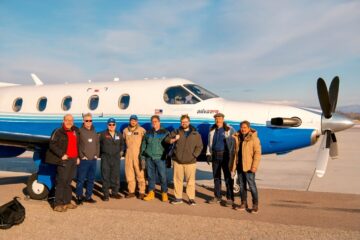Cleveland, OH, November 14 — Mosaic ATM conducted a flight test to assess radio propagation characteristics in low-altitude airspace. The test took place with the ground station (GS) transmitter at Burke Lakefront Airport (BKL) in Cleveland, Ohio. In addition to Mosaic ATM, key participants included the University of South Carolina (USC) and pilots from the Civil Air Patrol’s Maryland Wing. The goal was to measure channel impulse responses from a 5.24 GHz ground-based transmitter at BKL, with a receiver onboard the CAP aircraft. These channel impulse responses can be used to quantify key channel characteristics such as delay dispersion and path loss, critical to understand for very-high-reliability Advanced Air Mobility (AAM) communications.

Photo from one of the CAP flights, showing a stadium and downtown Cleveland. The transmitter is 1.6 nm away at BKL (not visible in this picture). Multipath interference from the buildings and the stadium was observed during this flight.
The CAP aircraft completed two missions at altitudes under 3,000 feet—typical of AAM operations. The transmitted signal encountered multipath reflections from objects in the environment, e.g., buildings, towers, and the Lake Erie water surface, as well as Doppler shifts due to the aircraft’s motion. Data from the missions, which flew around Lake Erie and near downtown Cleveland (1.6 nautical miles from the transmitter), will help better understand the signal environment for AAM aircraft. A total of approximately 32,000 channel responses were collected during the test.

Transmitter at BKL.
Significant multipath interference was observed from downtown Cleveland and the Cleveland Browns’ football stadium, as well as from other near-shore objects. For the second flight, which flew at an altitude of approximately 1000 feet, complete obstruction of the signal by the tallest buildings was also observed. Such obstructions typically attenuate the signal by several tens of dB.

Receiving equipment on board the CAP aircraft.
This test is part of the Toolkit for UAM Communications Management (TUCM) project, led by Mosaic’s Chief Research Scientist, Dr. Frederick Wieland. TUCM aims to predict signal path loss for AAM flights using Neural Networks (NN). Unlike traditional physics-based ray-tracing methods and statistical and hybrid deterministic-statistical models, this approach uses ray-tracing data to train NNs, enabling faster and accurate path loss predictions.
The November flight tests provide real-world data to validate the NN model, which can predict signal path loss 100 times faster than physics-based models. Once the data is fully processed, the accuracy of the NN predictions in real-world conditions will be evaluated. In addition, TUCM will contain statistical and hybrid deterministic-statistical models that are also based on measurements. While not as accurate as measurements or the final NN models, these models can give AAM service providers near-instantaneous results prior to the NN outputs.
Participants from the University of South Carolina included co-investigator Dr. David Matolak, professor of Electrical Engineering at the Molinaroli College of Engineering and Computing at the University of South Carolina, as well as Eddie King, a Technical Project Manager from USC. Joining them were two USC students, Chris Chau and Patrick Murphy. The two pilots from the Civil Air Patrol were John Ralph and Richard Marko. Dr. Frederick Wieland from Mosaic is the Principal Investigator of this project. The project is sponsored by NASA through their SBIR program. The NASA participants were Eric Knoblock and Rafael Apaza. For information on the CAP refer to Facebook @MarylandCivilAIrPatrol and @CivilAirPatrol and on X at @MDWGCAP.


For more information on this project, contact Dr. Frederick Wieland at fwieland@mosaicatm.com.
For further reading, see the paper:
Wieland, Frederick, et al. “Predicting AAM Path Loss through Neural Networks and Statistical Modeling.” 2024 Integrated Communications, Navigation and Surveillance Conference (ICNS). IEEE, 2024.


